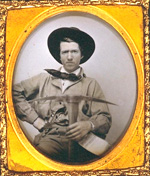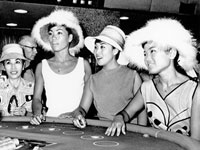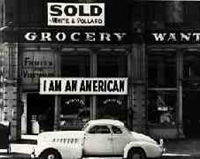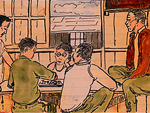In 1992, Congress passed Public Law 102.42, permanently designating May as Asian Pacific American Month. Just as with other heritage months, May is barely enough time to scratch the surface of the many strands of history the month memorializes. In May 2009, Teachinghistory.org suggested some places to start digging. Continue to dig this year, with more suggestions.
Japanese Americans and World War II
Modern history textbooks now recognize the internment of Japanese Americans in prison camps during World War II, and its violation of the U.S. understanding of citizenship has increasingly become a core strand in narratives about the war. Digital archives offer rich collections of primary sources related to the internments. Many of these sources feature children, making them a natural choice for drawing students into the story of history. Others focus on law, press, and the choices adults made both during and after the internment years.
- Students describe their own experiences of internment in the University of Arkansas's Land of (Un)Equal Opportunity. World War II-era high-school students' essays, poems, and other documents record the thoughts of modern students' historical peers.
- Densho: The Japanese American Legacy Project's archives preserve more than 900 hours of oral history interviews on Japanese American experiences, as well as 10,830 photographs, documents, and newspapers. Browsing them by topic reveals sources on little-covered aspects of the World War II era, such as the experiences of Japanese Hawaiians.
Chinese Americans
 The lives and experiences of all groups in the U.S. overlap and intertwine with each other, and no group's history exists in isolation. Japanese American history didn't begin and end with World War II, nor did it exist in a vacuum. Enter the keywords "registration certificate 1942" into the search box at the Columbia River Basin Ethnic History Archive for a primary source that captures the complicated nature of identity, perception, and categorization in U.S. history. Remember that Chinese and Japanese Americans are not the only groups represented by this artifact—consider what groups' views motivated the creation of this source.
The lives and experiences of all groups in the U.S. overlap and intertwine with each other, and no group's history exists in isolation. Japanese American history didn't begin and end with World War II, nor did it exist in a vacuum. Enter the keywords "registration certificate 1942" into the search box at the Columbia River Basin Ethnic History Archive for a primary source that captures the complicated nature of identity, perception, and categorization in U.S. history. Remember that Chinese and Japanese Americans are not the only groups represented by this artifact—consider what groups' views motivated the creation of this source.
Filipino Americans
Groups within the U.S. have often banded together based on shared identities to push for change. The Seattle Civil Rights & Labor History Project tells the story of Filipino Americans and unionism in the Seattle canning industry.
Korean Americans
World War II, the Korean War, and the whole span of U.S. international history and involvement (and lack of involvement) can shift when seen from different perspectives. The University of Southern California's Korean American Digital Archive includes photographs and documents related to international events—and to daily life.
Hawaiians
 Both a Pacific Island and a U.S. state, Hawaii has a unique position for Asian Pacific American Month. Many different cultures come together here, including Native Hawaiian, Filipino, Japanese, Korean, and Chinese, among others, and it is one of only four states where non-Hispanic whites do not form the majority. Sources on the history of many of these groups can be found in the digital archives of the University of Hawai'i at Manoa.
Both a Pacific Island and a U.S. state, Hawaii has a unique position for Asian Pacific American Month. Many different cultures come together here, including Native Hawaiian, Filipino, Japanese, Korean, and Chinese, among others, and it is one of only four states where non-Hispanic whites do not form the majority. Sources on the history of many of these groups can be found in the digital archives of the University of Hawai'i at Manoa.
More Resources
These resources touch on only a scattering of the many Asian American and Pacific American groups represented in the history of the U.S.—and only a scattering of the resources available to teachers. Comment and tell us what you use to teach Asian Pacific American history this month—and the rest of the year. What books, lesson plans, films, primary sources, and other materials have their place in your classroom and curriculum?

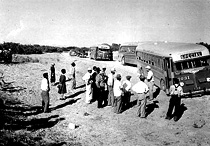

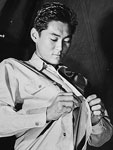
 The lives and experiences of all groups in the U.S. overlap and intertwine with each other, and no group's history exists in isolation. Japanese American history didn't begin and end with World War II, nor did it exist in a vacuum. Enter the keywords "registration certificate 1942" into the search box at the
The lives and experiences of all groups in the U.S. overlap and intertwine with each other, and no group's history exists in isolation. Japanese American history didn't begin and end with World War II, nor did it exist in a vacuum. Enter the keywords "registration certificate 1942" into the search box at the  Both a Pacific Island and a U.S. state, Hawaii has a unique position for Asian Pacific American Month. Many different cultures come together here, including Native Hawaiian, Filipino, Japanese, Korean, and Chinese, among others, and it is one of only four states where non-Hispanic whites do not form the majority. Sources on the history of many of these groups can be found in the
Both a Pacific Island and a U.S. state, Hawaii has a unique position for Asian Pacific American Month. Many different cultures come together here, including Native Hawaiian, Filipino, Japanese, Korean, and Chinese, among others, and it is one of only four states where non-Hispanic whites do not form the majority. Sources on the history of many of these groups can be found in the 